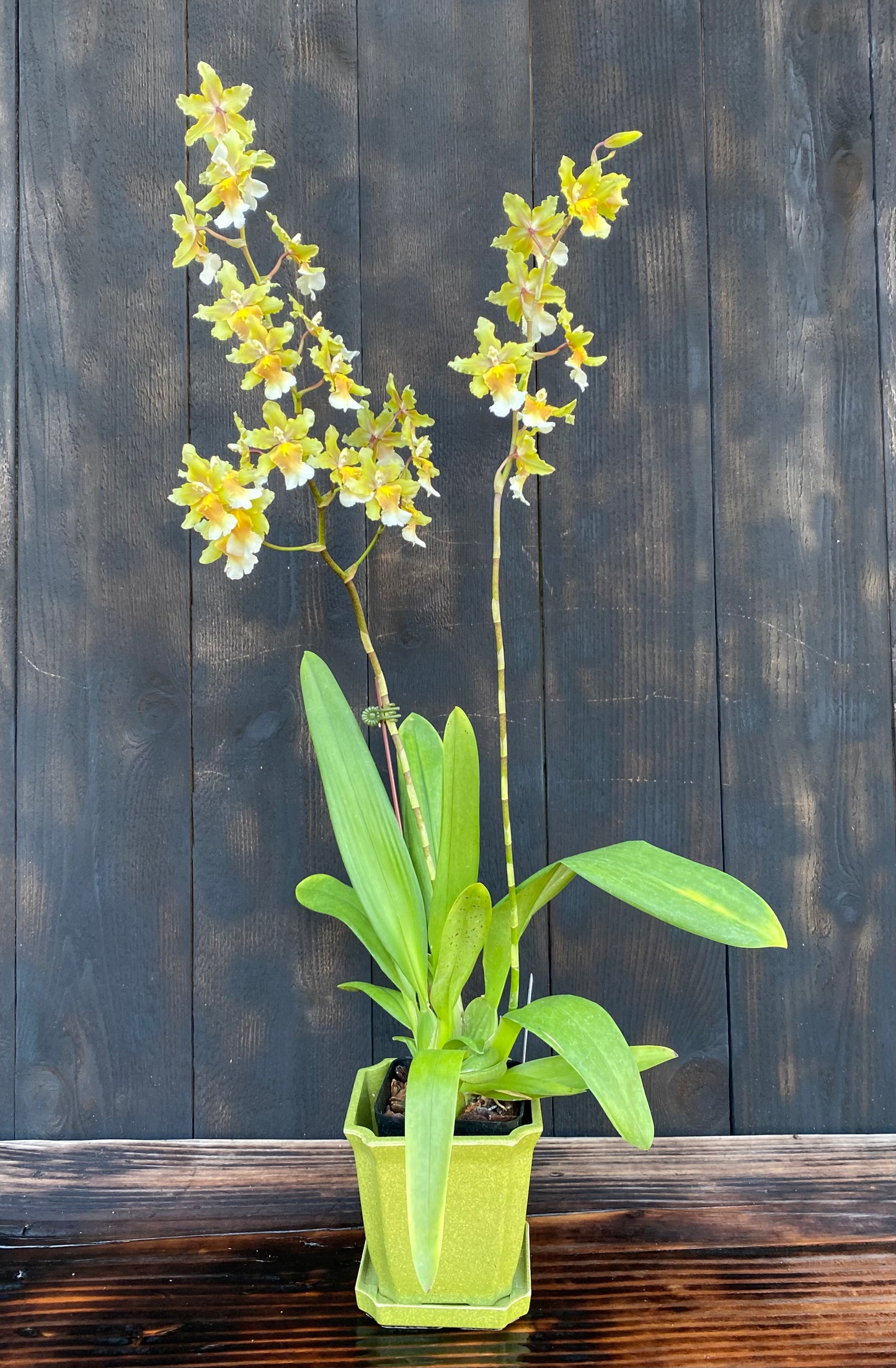Kalapana Orchid Farm
Oncostele Hot Cats
Oncostele Hot Cats
Couldn't load pickup availability
This is the quintessential 'Dancing Lady' orchid, and what a performer. Each 1-1.5 in. flower is dominated by a massive, ruffled 'skirt'—the labellum (lip). The color here is a beautiful, soft gradient. It begins with a bright, complex, buttery-yellow crest (callus) at the center, which then blushes into a wide, warm, rusty-orange or brownish-red across the mid-section. This, in turn, fades to a soft, creamy-white or pale yellow at the frilly, fluttering edge. The 'arms' and 'head' of the dancer (the petals and dorsal sepal) are a complementary chartreuse-yellow, framing the crisp white column. These delightful flowers are held in a branching spray (paniculate inflorescence) that can reach 2-3 ft. tall, creating an airy, dancing cloud of color.
The plant itself is a tidy, robust grower, forming clusters of ovoid, slightly flattened pseudobulbs about 2-3 in. high. Each pseudobulb is topped by one or two bright green, strap-like (ligulate) leaves that can be 10-15 in. long.
Quick Start
Light: Bright, 2,000–3,500 foot-candles (≈20–35k lux). Cattleya-level light.
Temps: Intermediate–Warm. Days 75–85°F (24–29°C); Nights 60–68°F (15–20°C).
Water: Water heavily when media is almost dry. Pseudobulbs store water, but don't let them stay bone-dry for long.
Humidity: 50–70%. Good air movement is critical.
Fertilizer: Weak (¼–½ strength), weekly during active growth.
Media: Medium-grade bark mix or sphagnum moss in pots. Must drain well.
🌺 Orchid Lore & Discovery Ons. Hot Cats isn't a species you'd find on a specific mountain; it's a masterpiece of modern hybridizing, combining the best traits of many ancestors. Registered in 1991, its parents are Onc. Hilo Hot and Onc. South Pacific.
If you pull that thread, you'll find this hybrid is the result of intensive line breeding, with plants like Onc. Memoria Thomas Fukuhara and Onc. Lava Flow appearing multiple times. This was done to lock in the most desirable traits: massive flower count, strong branching spikes, and vigorous growth.
The species behind this spectacle are a "who's who" of Oncidium:
Onc. flexuosum (Brazil): Lends the long, branching, "cloud-of-flowers" spike.
Onc. sphacelatum (Mexico, Central America): Contributes the sheer number of flowers and robust plant vigor.
Trichocentrum splendidum (Guatemala, formerly Onc. splendidum): Though further back, its "mule-ear" genetics likely add to the flower's large lip and good, waxy substance.
(A quick taxonomy note: As the Oncidium family has been reclassified, you may also see this hybrid listed as Oncostele Hot Cats, but it is widely known and grown by its original Oncidium name.)
🌿 How to Grow Oncidium Hot Cats Light Bright, dappled light is ideal. Think Cattleya-level light, around 2,000–3,500 foot-candles. Leaves should be a bright, grassy green. Too dark (deep forest green), and you'll get great leaves but no flowers. Too bright (yellowish with black spots), and the leaves will scorch.
Temperature This hybrid is very adaptable. It prefers intermediate to warm conditions: 75–85°F days, with a drop at night to 60–68°F. It can handle warmer temperatures, but you must increase humidity and airflow to compensate. It is not a fan of cold drafts below 55°F.
Water This is key. These plants have medium-sized pseudobulbs, which are their personal water tanks. Water thoroughly, drenching the pot, and then wait until the medium is just approaching dryness before watering again. Never let it sit in a saucer of water. When in active growth (producing new pseudobulbs or flower spikes), they are thirsty. Reduce water slightly after flowering.
Humidity Prefers 50–70%. While it enjoys humidity, it demands good air movement to prevent rot on the pseudobulbs or in the new, folded leaves. A stagnant, damp environment is its enemy.
Fertilizer Feed 'weakly, weekly.' Use a balanced fertilizer at ¼ to ½ strength with every watering during active growth (from the start of a new pseudobulb until it is fully formed). Flush the pot with plain water once a month to prevent salt buildup.
Media They are not fussy. A standard, well-draining Oncidium mix of medium-grade fir bark, charcoal, and perlite works perfectly. They can also be grown in sphagnum moss, but you must be careful not to overwater and should repot annually before the moss degrades.
Repotting Repot every 1-2 years, or when the media breaks down. The best time is just as new roots are starting to emerge from the base of the newest pseudobulb. They can get top-heavy when in spike, so a clay pot can add stability.
Grown in 4" pots. We are happy to send double and even triple spiking plants when available.
Share














